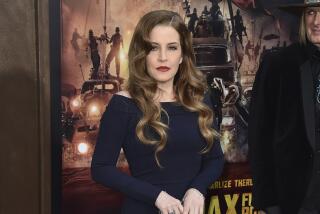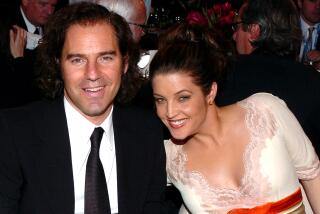Writer, lay therapist was devoted to husband’s legacy
Laura Archera Huxley, a lay therapist, author and widow of Aldous Huxley, who shared his vision of human potential and devoted the nearly five decades since his death to preserving his legacy and helping others -- particularly children -- achieve happiness, died Thursday at her home in the Hollywood Hills. She was 96.
The cause was cancer, said Dan Hirsch, a longtime friend.
Huxley met her husband in 1948, 16 years after his anti-utopian novel “Brave New World” had established him as a formidable thinker, writer and social critic. She married him in 1956, a year after the death of his first wife, and over the next seven years was his muse and partner in the explorations of consciousness that helped to spark the psychedelic movement of the 1960s.
After his death in 1963, on the day of President Kennedy’s assassination, she was determined to keep his works from slipping into obscurity.
“What Laura Huxley did was devote her life and energy and vision to making sure this very important writer in the Western canon was still in print and widely published,” said Jonathan Kirsch, the attorney for the Huxley literary estate.
One of her last projects was to bring “Brave New World” to the movie screen. It is now in development with a major motion picture studio, Kirsch said.
Huxley also was the author of several books, including an early self-help guide, “You Are Not the Target,” a 1963 bestseller. She also wrote “This Timeless Moment,” a 1969 memoir of her life with Aldous; “Between Heaven and Earth” (1974); “One-a-Day Reason to be Happy” (1986); and “The Child of Your Dreams” (1987).
In 1978 she founded a nonprofit group now called Children: Our Ultimate Investment, which aimed to foster optimal development of what she called the “possible human.” It collaborated with schools in California and in Britain, working particularly with teenagers to prevent unwanted pregnancies.
Huxley, who never had children of her own, once described its goal as “bringing children up loving the world, rather than fearing it as many children do.”
When she met her husband, Huxley was nearing the end of the first phase of her life -- as a concert violinist. Born in Turin, Italy, in 1911, she was a musical prodigy who performed for the queen of Italy when she was 14.
She came to the U.S. in the 1940s to make her American debut at Carnegie Hall. She wound up in Los Angeles, where she played for the Los Angeles Philharmonic for a few years. In 1948, spurred to make great changes in her life after the death of a close friend, she gave away her violin and went to work as a film editor at RKO studios.
She met the famous writer when she was trying to promote a film she wanted to make about the Palio di Siena, an annual horse race through the streets of Siena, Italy.
Director John Huston told her that if she could get Aldous Huxley to write the screenplay, he could help her obtain financing.
She wrote to the author, who had spent time in Italy and was then living in the desert outside Los Angeles. When she got no reply, she was a bit miffed.
She found his phone number and called him, unaware that the number belonged to a post office near where he lived. “They asked me if it was an emergency,” she recounted to the London Guardian in 2002, “and I said, ‘Of course it’s an emergency.’ ” The message got through, and she became a close friend to both Huxley and his wife, Maria.
After Maria died of cancer in 1955, he proposed to Laura in a roundabout way, asking if she had “ever been tempted by marriage.” When she said yes, he asked, “Do you think it might be amusing to travel to Yuma and get married at the drive-in?” She again replied affirmatively and they were married at a drive-in wedding chapel in Arizona.
By then he had already begun experimenting with psychedelic drugs, particularly mescaline. (His 1954 book on his experiences, “The Doors of Perception,” inspired Jim Morrison and his bandmates to name themselves The Doors.)
He invited Laura to take LSD with him while listening to Bach’s Fourth Brandenburg Concerto and they experienced “aesthetic revelations.”
But unlike their friend, Timothy Leary, who became the guru of a generation that turned on and dropped out, Huxley said she and her husband believed that while LSD had great potential for expanding consciousness, it should be used “very carefully and religiously.”
As a character in his last novel, “Island” (1962), said, such a drug “can take you to heaven but it can also take you to hell.”
When Aldous Huxley was dying of cancer, he asked his wife to give him a dose of the drug and she complied with two injections a few hours apart. He died peacefully shortly after the second dose. As she wrote of his last moments in her memoir, “I had the feeling that he was interested and relieved and quiet.”
When he was writing “Island” she was working on her first book, “You Are Not the Target,” a distillation of ideas she had been developing since the late 1940s about how to promote emotional health. She described her philosophy as recipes for life and offered exercises that would help people relieve stress and find joy.
One such exercise recommended tensing one’s stomach muscles after encountering a rude driver.
“It will reduce your waistline, increase circulation, liberate poison,” she said.
Another exercise was called “You Are Attending Your Own Funeral” and encouraged participants to review their life and let go of regrets.
She created her foundation after the granddaughter of a lifelong friend came to live with her for a week in 1978. Huxley told The Times in an interview that year that the child’s visit “threw me into a state of expanded consciousness. I wandered through the house feeling great love and compassion.”
Karen Pfeiffer, the child who opened up new vistas for Huxley, helps direct the foundation in Los Angeles. She recalled Huxley, who became her legal guardian, as “the most beautifully eccentric person I’ve ever known.”
Among Huxley’s many brainstorms was a room in Venice that she called the caressing room, where people could come to hold babies. She regarded it as a place “where the new and the old will meet and loneliness will dissolve,” she wrote in a description of the project in 1978. She said there should be such a place on every city block.
Well into her 90s, she worked out an hour a day on a treadmill and could balance herself on a rubber exercise ball. She practiced yoga and extolled the benefits of seeing the world upside down, standing on one’s head.
Asked many years ago why she never had children of her own, she replied, laughing, “I never thought I was old enough to have one.”
In addition to Pfeiffer and Pfeiffer’s daughter, Kaya, she is survived by a nephew, Piero Ferrucci of Florence, Italy, and a niece, Paola Ferrucci, of Turin, Italy.
--
More to Read
Sign up for our Book Club newsletter
Get the latest news, events and more from the Los Angeles Times Book Club, and help us get L.A. reading and talking.
You may occasionally receive promotional content from the Los Angeles Times.









